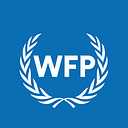The Great Enablers
Chapter 3: The latitude of scale
By Enrica Porcari, WFP Chief Information Officer and Director of Technology, and Dominik Heinrich, Director of Innovation and Knowledge Management

Successfully scaling up solutions to tackle real-world problems is often the difference between a good idea and a game-changing one.
WFP has always had a curious mind for the potential of innovation and technology to help fight hunger and positively impact the lives of the people it serves. Innovating to scale is in our DNA. It’s one of the reasons why WFP has remained agile, adaptive and relevant as humanitarian emergencies have grown in complexity and quantity. As the largest humanitarian organization in the world, our logistical know-how and footprint run the gamut by land, sea, air and everything in between.
Innovative solutions can sometimes be found through a bird’s eye view. Take the use of drones in humanitarian emergencies, which are low-cost to operate and can be deployed anywhere in the world assess damage, set up connectivity, map flooded areas, and monitor crops. WFP has been working since 2017 to scale-up the technology in a responsible manner, training humanitarian partners and working with national authorities to localize capacity. The approach paid off: in 2019, WFP deployed drones for the first time following Cyclone Idai in Mozambique, supporting the local response and offering unprecedented insight into the reality on the ground.
It’s human nature to want to help others in times of need, but how do you scale-up good intentions? Five years ago, WFP took a bold step using technology to make every cent count towards improving food security. The idea behind the SharetheMeal application is simple: leverage the collective power of the Internet and increased smartphone use through a simple app to get a new generation into the fight against hunger. US$0.80 can be enough to feed a child for a day in countries like the Democratic Republic of the Congo and Syria, making a big difference one meal at a time.

Innovation at scale can also be used to keep our eyes fixed on the global goal of achieving Zero Hunger. WFP’s HungerMapLIVE pulls and translates different data into a visual map with practical metrics like food security, nutrition, environmental hazards and conflict. The platform also monitors the progression of COVID-19. With so many variables in flux, it’s a tool that gives humanitarians a grasp of emerging trends in near real time, helping them improve their response.
At WFP, scaling up solutions is more than just extending our ability to intervene during crisis; implemented the right way, innovation at scale has the potential to help solve some of the greatest humanitarian challenges of our time — on the road to zero hunger.
More information on the themes explored in this series is available in a new WFP platform, which not only offers a glimpse of some of the innovation and technology behind the scenes of a 2020 Nobel Peace Prize Laureate, but also suggests practical ways that companies, entrepreneurs and individuals can work with us to achieve even more. Visit wfp.org/enablers.
